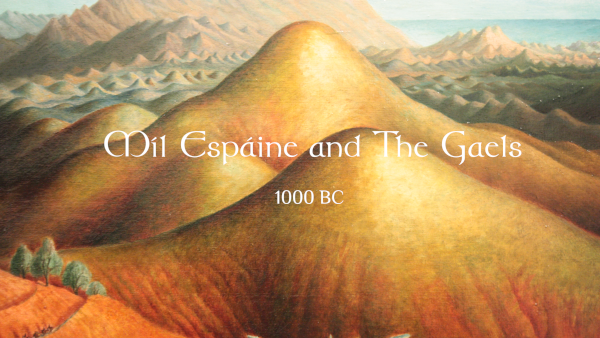Míl Espáine the Father of the Gaels
The Soldier of Hispania, Míl Espáine, documented in Historia Brittonum and Lebor Gabála Érenn served as a soldier in Scythia and Egypt.
Míl Espáine and a Druid’s Prophecy.
Míl’s descendants would rule the mystical island of Ireland, according to a prophecy. They could see the island on a clear day from the “Torre de Hercules”, in A Coruña, Galicia.
Observing the mystery of the island from the tower, Míl’s uncle Íth set sail. Íth would never return. News broke to Míl, his uncle is dead. The party of conquest explained to Míl that they were victims of an ambush by a strange group of people inhabiting the island. The Son’s of Míl set out for revenge.
An Encounter with the Tuatha De Danaan
The Son’s of Míl became quickly acquainted with the inhabitants of Ireland while arriving on the Island. They noticed that the inhabitants possessed incredible knowledge regarding esoteric practices. They were also simultaneously skilled in warfare, which was a necessary defence from the raiding Fomorians.
The Milesians then encountered three women from amongst the Tuatha De Danaan, Ériu, Banba and Fodla. All three ladies requested that if the Milesians were to live on the island, they must name the island after one of them.
The Treaty
The three Kings of the Tuatha de Danaan requested a truce, who subsequently were the husbands of the three ladies. For the entirety of the three days the Milesians must return to their ships and lie at anchor nine waves’ distance from the shore. In one last attempt to remove the invaders, the Tuatha De Danaan mustered a magical storm to drive them away. The Milesian poet Amergin responded by calming the sea with his verse. The Milesians then sailed towards the shore and defeated the Tuatha De Danaan once and for all.
The Settlement of Míl Espáine’s Progeny
The victorious Milesians divided the land between the two parties. Amergin cleverly allotted the portion above the ground to the Milesians and the portion underground to the Tuatha De Danann. The Tuatha De Danaan were led underground into the Sidhe mounds and Tir na nOg, while the Milesians remained on the surface of Ireland, becoming the Gaelic Irish.
Míl Espáine
Míl Espáine would never make it to Ireland, dying in Iberia. However, the Irish would look upon him as a father. A patriarch of the Gaels.
Legacy
In the advent of modern scientific discoveries, especially within genealogy, some of the origin stories of the ancient Irish have come under scrutiny. This is not to say that what was once believed has now become defunct. It has only provided further information, which can be interpreted in a variety of different ways.
Within the story we can see that Míl looked out towards Ireland in wonder. He had a calling to travel and experience new surroundings. It can be said that this is apparent within the Gaelic people’s psychology. The Irish and Scottish diasporas around the world are tantamount to this.
The encounter with the female Ériu, who the Island was named after, also provides some insight into the idea of sacred femininity, which the Irish people have recognised throughout the ages. Examples of this would be the sanctification of Brigid and the reverence paid to the Mother of Jesus, Mary.

